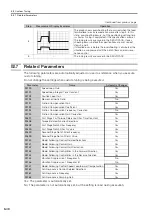
8.8 Custom Tuning
8.8.5 Automatically Adjusted Function Settings
8-47
8
T
uning
•
Vib Detect
Button
While the notch filter or anti-resonance control adjustment automatic setting function is
enabled, you can click the
Vib Detect
Button to manually detect vibration. When you
click the
Vib Detect
Button, the SERVOPACK will detect vibration at that time, and set
the notch filter frequency (stage 1 or 2) or anti-resonance control frequency that is
effective for the detected vibration. You can also perform manual vibration detection
even when the SERVOPACK does not detect vibration.
•
Anti-res Ctrl Adj
Button
You can use the
Anti-res Ctrl Adj
Button to execute the anti-resonance control func-
tion if fine-tuning is required. Refer to the following section.
8.9 Anti-Resonance Control Adjustment
•
Vib Suppress
Button
Click the
Vib Suppress
Button to suppress low and transient vibration (oscillation) of
approximately 1 Hz to 100 Hz that occurs during positioning. Refer to the following
section.
Autotuning with a Host Reference
You can perform autotuning with a host reference. Refer to the following section for details.
8.7 Autotuning with a Host Reference
8.8.5
Automatically Adjusted Function Settings
You cannot use vibration suppression functions at the same time. Other automatic function set-
tings are the same as for autotuning without a host reference. Refer to the following section.
8.6.6 Automatically Adjusted Function Settings
8.8.6
Tuning Example for Tuning Mode 2 or 3
Step
Measurement Display Examples
Operation
1
The positioning time is measured after the moment of inertia
ratio (Pn103) is set correctly.
Tuning is completed if the specifications are met.
The tuning results are saved in the SERVOPACK.
2
The positioning time will be reduced if the feedforward level is
increased.
Tuning is completed if the specifications are met. The tuning
results are saved in the SERVOPACK.
If overshooting occurs before the specifications are met, pro-
ceed to step 3.
3
Overshooting will be reduced if the feedback level is
increased.
If the overshooting is eliminated, proceed to step 4.
Continued on next page.
Position
deviation
Reference
speed
Positioning
completion signal






























